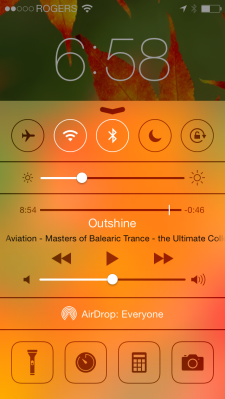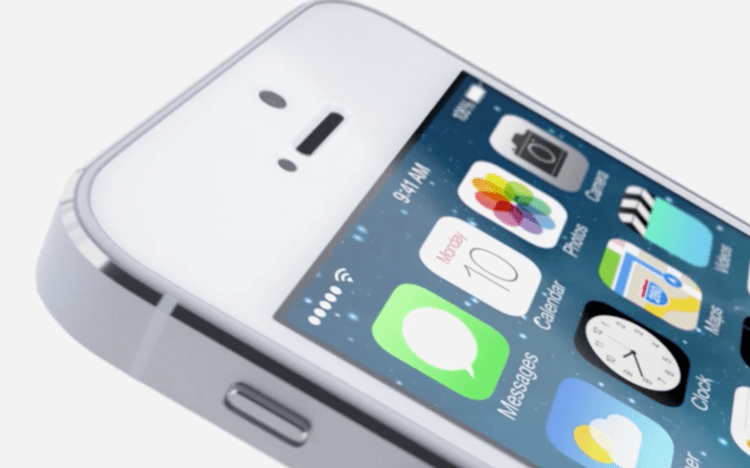iOS 7 is arguably the biggest change to Apple’s mobile operating system in recent years. I’ve been using it in various beta forms for the last three months, and it’s the best mobile operating system Apple has ever delivered.
The question, however, on the day when Apple ships iOS to hundreds of millions of people around the globe, is whether it’s the best mobile operating system — period.
The best new features of iOS 7 are pretty obvious: Control Center, Notification Center, a new camera app with improved features, and — something that doesn’t get a lot of play in iOS 7 reviews — a new feature from Apple that means the end of manually updating apps.
At least three of them are, shall we say, “inspired” by Android.
Best new features
 Control Center lets you access key and often-used features from any screen on your phone, even the lock screen, simply by swiping up from the very bottom of the screen. Turning Wi-Fi, Bluetooth, and Airplane mode on or off, changing screen brightness, controlling your music, and accessing key apps such as the clock, calculator, camera, and a new flashlight app are now as simple as one swipe and one tap.
Control Center lets you access key and often-used features from any screen on your phone, even the lock screen, simply by swiping up from the very bottom of the screen. Turning Wi-Fi, Bluetooth, and Airplane mode on or off, changing screen brightness, controlling your music, and accessing key apps such as the clock, calculator, camera, and a new flashlight app are now as simple as one swipe and one tap.
That’s all good.
Notification Center is in some ways the reverse of Control Center. Instead of an upward swipe from the bottom, you reach Notification Center via a downward swipe from the top to get immediate access to a much richer set of information than you’ve had access to in the past: your calendar, weather, reminders, stocks or other widgets you’ve set up, and a little note about what’s coming up tomorrow.
Tap on any one of them, and you’ll find yourself in the associated full-fledged app to add, edit, or get full details.
And perhaps one of the most useful features of iOS 7 is something that you completely forget about within days or weeks of upgrading: iOS 7 automatically updates apps in the background. This is huge — you never see that irritating little incrementing number beside the app store icon, reminding you that there is something to do, some work to be completed, something that requires your attention.
I’ll elaborate on that, because here Apple has taken a step out of managing and maintaining your mobile device that wasn’t necessary, treated users like trained monkeys (here’s an app to update, tap the button, update the app, rinse and repeat daily), and was annoying.
But this new feature — and features similar to Control Center and Notifications Center — first appeared on Android.
 The new Camera app is much improved. It lets you swipe horizontally anywhere on the image to access different picture modes like panoramic, square, or video. And it includes new filters that allow you to choose Noir, Chrome, Mono, or other effects. But it also features a new Photos app that intelligently groups photos together in virtual albums so that sorting through and finding photos is much easier — and browsing photos is a much more enjoyable experience.
The new Camera app is much improved. It lets you swipe horizontally anywhere on the image to access different picture modes like panoramic, square, or video. And it includes new filters that allow you to choose Noir, Chrome, Mono, or other effects. But it also features a new Photos app that intelligently groups photos together in virtual albums so that sorting through and finding photos is much easier — and browsing photos is a much more enjoyable experience.
Instead of hitting a wall of undifferentiated visual data, you’re now presented with albums that are grouped by location and time of capture that are surprisingly good, and surprisingly helpful.
I now have insta-albums that include Home — photos I’ve taken around my house — a recent family trip to an outdoor climbing center, a visit to the Hope Slide, and photos from the Grow Conference in Vancouver. As someone who almost never takes the time to sort photos after the fact, this is huge. And it makes photos much more fun.
Yes, the look, the look, the look
The biggest change to iOS 7, of course, is the look. When you first see iOS 7, there are significant changes to the operating system and also to the core Apple apps — not enough to make you fail to recognize iOS, but enough to make you think that you can’t really go home again: it has changed, or you have, or both.
When I first reviewed iOS 7 in June, I called it the “essence of less.” Simplicity is the ultimate sophistication, I said, and Apple’s new mobile operating system was very sophisticated indeed.
So much so, actually, that it was too simple.
In an attempt to kill the cruft and the chrome, the interface that has grown up from “real-world’ referents that included green felt in Game Center, faux leather and stitching in Notes, and heavily styled 3D buttons that look like they’d depress with a big meaty ker-thunk as you tap them are all gone. Left is the actual core of what was needed.
There’s something in the flat design and in the bright colors Apple chose as its primary palette for the new operating system that is reminiscent of Windows Phone. But the overarching goal was deference to the data: less inter, more face, as I said back in June.
Apple’s still there, but some of the juvenilia of iOS 7 in which it went too far — buttons were de-emphasized so much that you didn’t know what to press and weren’t sure when something was depressed or active or not — has been dialed back a few notches. The phone app in particular, which was so minimalistic that it was challenging to tell when you were on speakerphone has been slowly updated through various iOS 7 betas until now the app is still minimal, but also clear.
iOS 7 and the jolly green robot
Perhaps, in a sense, iOS 7 is the first natively digital phone interface, free from pretending to be something from yesterday. Google’s not far off either, but it still offers an “app drawer” and other reminders that this is a virtual thing you are holding in your hands that is based on past physical things.
But there’s no doubt that many of the features that are big in iOS 7 are inspired by Android, or at least by apps, widgets, and add-ons to Android that offered Notification Center-like capabilities, Control Center-like capabilities, and automatic background app updating.
That said, there’s also no doubt that Apple still does it better and cleaner and more elegantly than anyone else, which allows iOS to credibly retain its claim to be the world’s best mobile operating system with version 7.
Of course, Google never rests on its laurels. And when KitKat comes out soon, we’ll have yet another comparison to make.
VentureBeat's mission is to be a digital town square for technical decision-makers to gain knowledge about transformative enterprise technology and transact. Learn More



